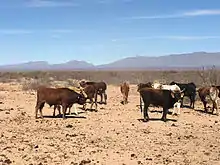Raramuri Criollo
The Rarámuri Criollo is a landrace biotype of Criollo cattle indigenous to the Sierra Tarahumara region of the Copper Canyon, Mexico.[1][2] In 2005 a small group was introduced to the Jornada Experimental Range (JER) in New Mexico, in the United States for scientific study.[1]


History
Rarámuri Criollo cattle are descendants of the first cattle brought to Mexico by Hernán Cortés and Villalobos.[1] Until recently, this biotype was geographically isolated between Chínipas and Témoris, Chihuahua in the remote Rio Oteros region of the Copper Canyon, home to the Tarahumara.[1] The Tarahumara, who also call themselves Rarámuri, meaning "fleet foot",[3] have raised this biotype for over 400 years. The Rarámuri Criollo has seen little artificial selection and is suspected to have little-to-no genetic introgression from outside breeds, therefore scientists consider it important to preserve their unique genetic and behavioral characteristics.[1]
Characteristics
The Rarámuri Criollo has characteristic lyrate horns like those of its ancestors and exhibits a wide variety of coat colors. It is generally smaller than other beef breeds, but is large among North American Criollo cattle. Rarámuri Criollo are very sexually dimorphic and typically cows weigh 370 kg (816 lbs), while bulls can weigh more than 620 kg (1367 lbs).[4] Currently, no registered breed association exists for the biotype, but they are regarded as an individual among other Criollo cattle.[1][5][6]
Behavior
In collaborative ethological scientific studies between the USDA-ARS's JER and New Mexico State University, Rarámuri Criollo cows have consistently exhibited unique behavioral traits when compared to traditional British breeds; for instance, they tend to explore larger areas and travel further distances per day, especially in the harsh dry seasons of the American southwest.[7] These animals have also been shown to exhibit a different mothering style during early infantile calf stages, wherein cows and calves act as "followers" (young are kept closer to the mother) as opposed to "hiders" (young are hidden or kept with a guardian cow during foraging bouts) as do British crossbreds (eg. Black Baldies).[8][9] These cattle are under continuous scientific study because these behavioral traits are suspected to be more environmentally sustainable, especially under the impending threat of climate change, than those exhibited by more traditional breeds as increased exploration, reduced water dependency, and spatial non-constraints by calving mean that cows are less likely to overuse patches of vulnerable desert vegetation thus ensuring resilience of those biological rangeland resources.[10]
Uses
The Rarámuri Criollo was initially used by early Spanish explorers and the Tarahumara for milk, draught, and companionship,[1] but are now considered a novel beef breed.[1][11] Some preliminary analyses show that Rarámuri Criollo have an exceptionally long reproductive lifespan (> 22 years).[12] Other baseline data indicates that grass-finished steers will weigh 800 - 1000 lbs at 30 months of age and yield extremely tender meat, suggesting that they may be a viable alternative for producers seeking to raise grass-fed cattle in arid environments with limited resources.[1]
See also
| Wikimedia Commons has media related to Rarámuri Criollo cattle. |
References
- Anderson, Dean M., Rick E. Estell, Alfredo L. Gonzalez, Andres F. Cibils, and L A. Torell. "Criollo cattle: Heritage Genetics for Arid Landscapes." Rangelands 37.2 (2015): 62-67. Print.
- J.E. Rouse. The Criollo Spanish cattle in the Americas. University of Oklahoma Press, Norman, OK, USA (1977) 303 pp. (WorldCat)
- A. Paredes, L.J. West, C.C. SnowBiosocial adaptation and correlates of acculturation in the Tarahumara ecosystem Int J Psychiatry, 16 (1970), pp. 163-174
- McIntosh, M., Gonzalez, A.L., Cibils, A., Estell, R.E., Nyamuryekung'e, S., Spiegal, S.A. 2020. A preliminary phenotypic characterization of Raramuri Criollo cattle. Journal of Animal Science Supplement. 98, Supp S3.
- Gonzalez, Alfredo (October 19, 2015). "History and Genetics of Criollo Cattle".
- McIntosh, Matthew; Gonzalez, Alfredo; Cibils, Andres; Estell, Rick; Nyamuryekunge, Shelemia; Almeida, Felipe Rodriguez; Spiegal, Sheri (2020-11-05). "A Phenotypic Characterization of Rarámuri Criollo Cattle Introduced into the Southwestern United States". Archivos Latinoamericanos de Producción Animal. 28 (3–4): 111–119. ISSN 2075-8359.
- Peinetti, H.R., Fredrickson, E.L., Peters, D.P., Cibils, A.F., Octavio Roacho-Estrada, J. and Laliberte, A.S., 2011. Foraging behavior of heritage versus recently introduced herbivores on desert landscapes of the American Southwest. Ecosphere, 2(5), pp.1-14.
- Spiegal, S., Estell, R.E., Cibils, A.F., James, D.K., Peinetti, H.R., Browning, D.M., Romig, K.B., Gonzalez, A.L., Lyons, A.J. and Bestelmeyer, B.T., 2019. Seasonal divergence of landscape use by heritage and conventional cattle on desert rangeland. Rangeland ecology & management, 72(4), pp.590-601.
- Nyamuryekung’e et al., n.d Nyamuryekung’e, S., Cibils, A. F., Estell, R. E., VanLeeuwen, D., Steele, C., Estrada, O. R., Almeida, F. R., Gonzalez, A., and Spiegal, S. Do young calves constrain movement patterns of nursing Raramuri Criollo cows on rangeland? in review.
- Spiegal, S., Estell, R., Cibils, A.F., Browning, D.M., Peinetti, H.R., James, D., Romig, K. and Gonzalez, A., 2016, August. Can foraging behavior of Criollo cattle help increase agricultural production and reduce environmental impacts in the arid Southwest?. In Ecological Society of America Abstracts (No. 62011). Paper.
- Scasta, J.D., Lalman, D.L. and Henderson, L., 2016. Drought mitigation for grazing operations: matching the animal to the environment. Rangelands, 38(4), pp.204-210.
- E.L. FredricksonAge of maturity for Criollo heifers. SWGLA/Forage for thought Available at: http://www.grassfedlivestock.org/wp-content/uploads/2014/07/SWGLA-Newsletter-Fall-2008.pdf?db3584 (2008) Accessed 26 February 2015.